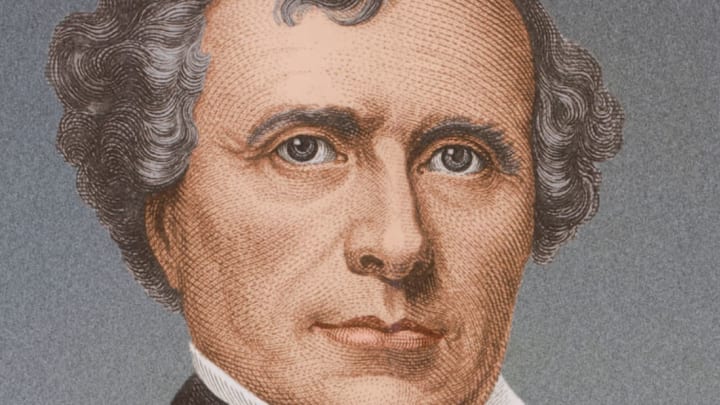by David Holzel
Here are five fun and possibly amazing facts about the man they called "Young Hickory of the Granite Hills."
1. He is America's most obscure president.
One in a series of forgettable mid-19th-century presidents, Pierce, who served from 1853-1857, is arguably the most forgettable. Thirteenth president Millard Fillmore is generally regarded as America's least-known president. That is a distinction Franklin Pierce lacks, making him even more obscure than Fillmore.
2. He may not have hit that woman with his carriage.
Pierce was denied renomination by the Democratic Party in 1856 (the only elected president to have been rejected so out of hand). After being given the heave-ho, he has widely been quoted as telling a friend, "There is nothing left to do but get drunk."
While many of us in the same position would stop at the nearest tavern for a session of Beer Pong, the story sounds apocryphal. Presidential historian Paul Boller repeats the quotation in his book, Presidential Diversions (Harcourt, 2007). When I asked him about it, he said Pierce must have been joking.
Pierce unquestionably drank heavily during certain periods of his life, and alcoholism contributed to or caused his death. But he didn't make a habit of announcing it.
Another story—that Pierce ran over an elderly woman with his carriage—is almost certainly false, according to historian Peter Wallner, author of Franklin Pierce: Martyr for the Union.
"The fact that there are no newspaper stories about the accident and it wasn't mentioned in any correspondence convinced me that it probably didn't happen," Wallner told me.
3. He took on the mob. Or at least a mob.
As a staunch Democrat and believer in following the strict meaning of the Constitution, Pierce was an outspoken critic of the Civil War as prosecuted by Republican Abraham Lincoln, whose approach to constitutional freedoms was more free-form. After Lincoln was assassinated, a group of citizens in Pierce's hometown of Concord, N.H., gathered on the street to express their grief and to confront neighbors who were not displaying the flag in that moment of national tragedy.
Eventually some 200-400 Concordians reached Pierce's house and, as Wallner recounts in Franklin Pierce: Martyr for the Union, demanded to know where the former president was keeping his flag.
"It is not necessary for me to show my devotion for the stars and stripes," Pierce replied testily, and then reiterated his patriotic bona fides by recalling his ancestors' participation in the Revolution and the War of 1812, and his own 35-year service to New Hampshire and the nation.
Whether he swayed the crowd with his oratory, or just wore them down, the mob gave Pierce three cheers and dispersed without burning his house down.
4. He was a better ex-president.
Like Jimmy Carter, Pierce was a better ex-president than president, if for no other reason than he no longer was in office. He spent much of his time tending to his wife, Jane, who was dying slowly of tuberculosis. The couple spent the winter of 1857-58 in the Portuguese islands of Madeira, where they studied French in anticipation of a tour of the continent.
Their European travels during 1858-59 took them to Switzerland and Italy, Paris, and London. Once back in the USA, Pierce busied himself by purchasing various pieces of property in his home state of New Hampshire.
He also kept up a steady stream of political correspondence and, before he and Jane left to spend the winter of 1859-60 in the Bahamas, Pierce wrote to his former secretary of war, Jefferson Davis, urging him to be the Democratic Party's "standard bearer in 1860," according to Wallner. Jane Pierce died on Dec. 2, 1863, at age 57.
5. He perfected the comb-over.
Pierce had some of the finest hair of any U.S. president. One witness described it approvingly as a "mass of curly black hair combed on a deep slant over his wide forehead." And that was after viewing Pierce's body in state after his death in 1869.
Yet that mass of curls may have been an act of misdirection away from the truth that deep slant hinted at. In an 1862 photograph, Pierce's hair in profile appears to exist on two levels "above, the hair combed on a deep slant, and below, a small patch at the front and center of his wide forehead."
Pierce's hair unquestionably is a subject for future historians to wrestle with.
